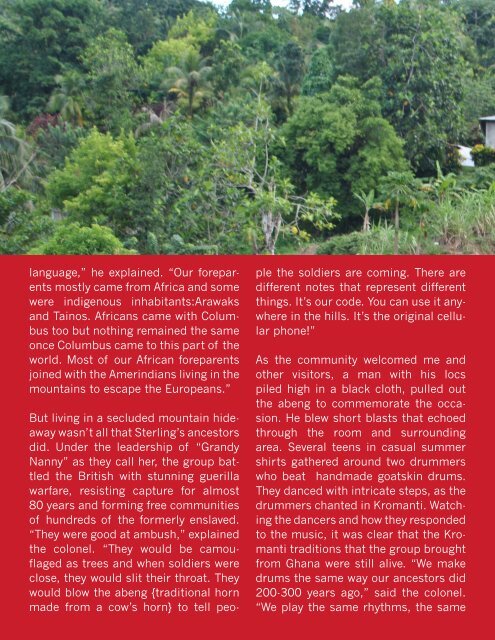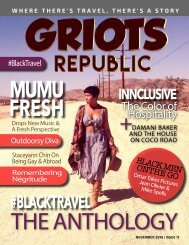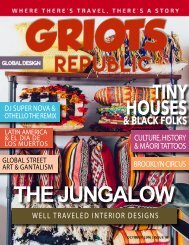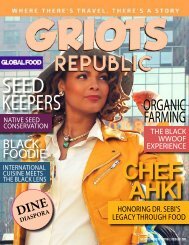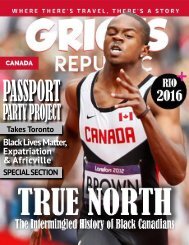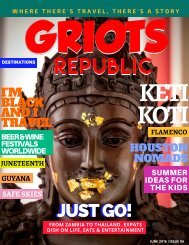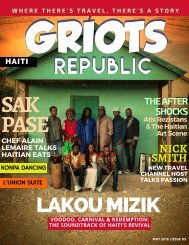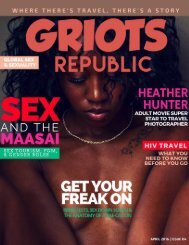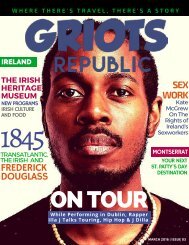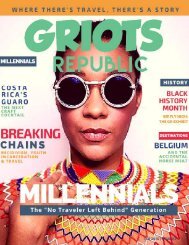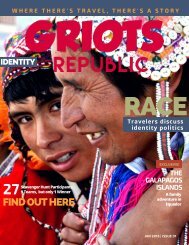GRIOTS REPUBLIC - AN URBAN BLACK TRAVEL MAG - DECEMBER 2016
2016 is coming to an end and in this issue of Griots Republic Barrington Irving and Calvin Ramsey join us to talk about the Legacy of Black Travel. We also have stories on Moore Town's Freedom Fighter, Global Bath House Culture, Christmas Markets in Cologne, and the Cocktail scene in Shanghai. Do not miss our "REAL" articles on "Runcations" and traveling to Antartica!
2016 is coming to an end and in this issue of Griots Republic Barrington Irving and Calvin Ramsey join us to talk about the Legacy of Black Travel. We also have stories on Moore Town's Freedom Fighter, Global Bath House Culture, Christmas Markets in Cologne, and the Cocktail scene in Shanghai. Do not miss our "REAL" articles on "Runcations" and traveling to Antartica!
Create successful ePaper yourself
Turn your PDF publications into a flip-book with our unique Google optimized e-Paper software.
language,” he explained. “Our foreparents<br />
mostly came from Africa and some<br />
were indigenous inhabitants:Arawaks<br />
and Tainos. Africans came with Columbus<br />
too but nothing remained the same<br />
once Columbus came to this part of the<br />
world. Most of our African foreparents<br />
joined with the Amerindians living in the<br />
mountains to escape the Europeans.”<br />
But living in a secluded mountain hideaway<br />
wasn’t all that Sterling’s ancestors<br />
did. Under the leadership of “Grandy<br />
Nanny” as they call her, the group battled<br />
the British with stunning guerilla<br />
warfare, resisting capture for almost<br />
80 years and forming free communities<br />
of hundreds of the formerly enslaved.<br />
“They were good at ambush,” explained<br />
the colonel. “They would be camouflaged<br />
as trees and when soldiers were<br />
close, they would slit their throat. They<br />
would blow the abeng {traditional horn<br />
made from a cow’s horn} to tell people<br />
the soldiers are coming. There are<br />
different notes that represent different<br />
things. It’s our code. You can use it anywhere<br />
in the hills. It’s the original cellular<br />
phone!”<br />
As the community welcomed me and<br />
other visitors, a man with his locs<br />
piled high in a black cloth, pulled out<br />
the abeng to commemorate the occasion.<br />
He blew short blasts that echoed<br />
through the room and surrounding<br />
area. Several teens in casual summer<br />
shirts gathered around two drummers<br />
who beat handmade goatskin drums.<br />
They danced with intricate steps, as the<br />
drummers chanted in Kromanti. Watching<br />
the dancers and how they responded<br />
to the music, it was clear that the Kromanti<br />
traditions that the group brought<br />
from Ghana were still alive. “We make<br />
drums the same way our ancestors did<br />
200-300 years ago,” said the colonel.<br />
“We play the same rhythms, the same


